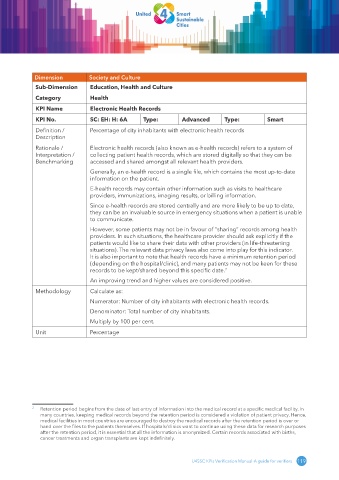Page 129 - U4SSC KPIs Verification Manual - A guide for verifiers
P. 129
Dimension Society and Culture
Sub-Dimension Education, Health and Culture
Category Health
KPI Name Electronic Health Records
KPI No. SC: EH: H: 6A Type: Advanced Type: Smart
Definition / Percentage of city inhabitants with electronic health records
Description
Rationale / Electronic health records (also known as e-health records) refers to a system of
Interpretation / collecting patient health records, which are stored digitally so that they can be
Benchmarking accessed and shared amongst all relevant health providers.
Generally, an e-health record is a single file, which contains the most up-to-date
information on the patient.
E-health records may contain other information such as visits to healthcare
providers, immunizations, imaging results, or billing information.
Since e-health records are stored centrally and are more likely to be up to date,
they can be an invaluable source in emergency situations when a patient is unable
to communicate.
However, some patients may not be in favour of “sharing” records among health
providers. In such situations, the healthcare provider should ask explicitly if the
patients would like to share their data with other providers (in life-threatening
situations). The relevant data privacy laws also come into play for this indicator.
It is also important to note that health records have a minimum retention period
(depending on the hospital/clinic), and many patients may not be keen for these
records to be kept/shared beyond this specific date. 2
An improving trend and higher values are considered positive.
Methodology Calculate as:
Numerator: Number of city inhabitants with electronic health records.
Denominator: Total number of city inhabitants.
Multiply by 100 per cent.
Unit Percentage
2 Retention period begins from the date of last entry of information into the medical record at a specific medical facility. In
many countries, keeping medical records beyond the retention period is considered a violation of patient privacy. Hence,
medical facilities in most countries are encouraged to destroy the medical records after the retention period is over or
hand over the files to the patients themselves. If hospitals/clinics want to continue using these data for research purposes
after the retention period, it is essential that all the information is anonymized. Certain records associated with births,
cancer treatments and organ transplants are kept indefinitely.
U4SSC KPIs Verification Manual-A guide for verifiers 119

